
Alcatraz was unique home for staff families
SAN FRANCISCO — The sun is shining, birds are chirping, flowers are in bloom and there is not a cloud in the sky. The blue pristine waters are calm and the wind from the bay creates a chilly brisk temperature. The sounds of children playing echo off the mountains in the distance, which are so clear that they seem unreal.
The year is 1943, the location, Alcatraz Island.
 |
A view of Alcatraz Island from the Alcatraz Cruises ferry (Photo by Alcione Gonzalez). |
Although Alcatraz is most notorious for its prison, it was also considered home for many officers and guards along with their wives and children. In fact, life on Alcatraz Island, now part of the Golden Gate National Recreation Area, was almost —but not quite— like any other offshore community.
With about 300 civilians living on the island, including 60 to 80 children, everyone worked and played together.
“I have nothing but happy memories from living here,” said Ernest B. Lageson, the newsboy of the island, as well as the son of an Alcatraz officer and island resident from 1943 to 1946 and is now 75 years old. “We did the same things you would do in the city.”
| Ernest Lageson, son of Officer Ernest Lageson, lived on the island with his parents from 1943-46. He visits the bookshop for book signings (Photo by Lily Stofman). |
 |
During the time it operated as a federal penitentiary from 1934 to 1963, the public was fascinated by Alcatraz. Telescopes were installed in San Francisco near today’s Fisherman’s Wharf and boats circled the island hoping to catch a glimpse of desperate men and horrendous conditions.
However, it was just the opposite. On the island was an Officer’s Club, which was built in 1912 by the U.S. Army (the island was a military prison from 1859 to 1934) and became the center of social activity for Alcatraz residents. It was there that residents would spend their days playing in the bowling alley, working out in the gymnasium and dancing the night away in their very own dance hall.
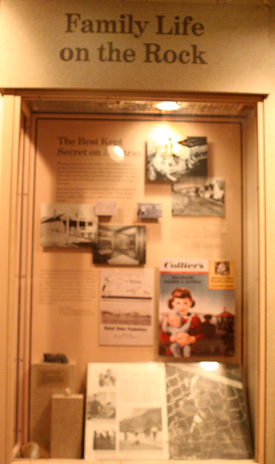 |
An exhibit on Alcatraz digs deep into the life of those who lived on the island and called it home (Photo by Lily Stofman). |
Children spent their days playing ball in the designated areas, as well as playing jump-rope, billiards and even fishing. There was also an Alcatraz ballet that held bi-weekly practices for girls living on the island.
A post office as well as a general store also made the island even more of a complete community and a quality place to live. Both were built in 1934 and were operated by the residents. Although the general store was convenient, major shopping was done in the city.
| Miami visitor Alcione Gonzalez poses in front houses where veteran officers resided (Photo by Lily Stofman). |
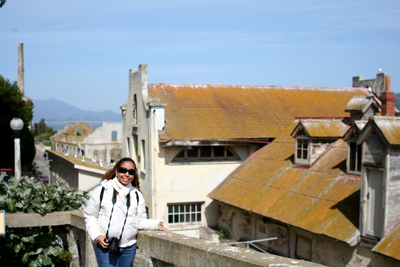 |
A motor launch ferry would make 20 runs per day, back and forth from San Francisco during the hours of 6 a.m. to 1 a.m. Many residents took advantage of this transportation, with the officer’s wives and school children being the most regular passengers.
“It was fabulous living on the island and kind of a novelty,” said Jolene Babyak, daughter of an associate warden and island resident during the 1950s, who spoke about her time on Alcatraz as part of a video presentation shown to visitors of the island. “We took a boat to school and came back to a quiet island with no traffic.”
| A sign tells prison visitors: “Warning: Persons Procuring or Concealing Escape of Prisoners are Subject to Prosecution and Imprisonment” (Photo by Lily Stofman). |
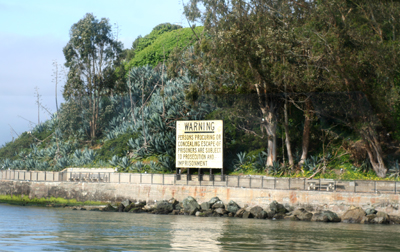 |
They became so accustomed to their not-so-ordinary lives that they grew to be oblivious to their reality as well as the signs posted around the island. One of which read, “Warning: persons procuring or concealing escape of prisoners are subject to prosecution and imprisonment.”
“I guess the island was a special place to grow up,” said Joyce Rose Ritz, daughter of an Alcatraz officer and an island resident from 1934 to 1951, who wrote about her experience as part of an exhibit called Family Life on The Rock. “Looking back now, I can see how different it was, but the island was never a scary or bad place to any of us. It was home.”
As for the inmates, residents hardly saw them and never feared them. It is a known fact that residents felt so secure that they never even locked their doors. Philip Bergen, former captain of the guards, called Alcatraz a “small town with a big jail.”
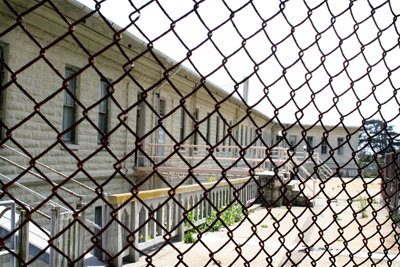 |
New guards and families lived in this building. Wives and children were restricted to this fenced residential area (Photo by Lily Stofman). |
“We would see the inmates every-so-often and most were very gregarious,” said Lageson. “Some would even chat with the kids, depending on the supervisor that was on duty. We knew they were dangerous men, but we felt as ease with them because the officers were someone’s dad, so we never felt threatened.”
Lageson even admits that there was an element of romance being on the island. Whenever he would see an inmate, he would ask his dad, “What’s he in for?”
Interestingly enough, Lageson and his family went through a very traumatic event when his father, Ernest Lageson Sr., was involved in the so-called “Battle of Alcatraz” in May 1946. However, he still only has fond recollections of the island.
| Alcatraz Prison Officer Ernest Lageson lived on the island with his wife, and son, Ernest. He was involved in the “Battle of Alcatraz” (Photo by Lily Stofman). |
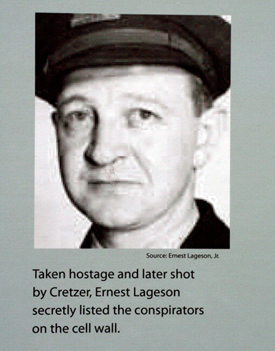 |
After months of planning, six inmates attempted to escape from the cell house, but ultimately failed because the key they needed to exit the cell house was missing. For three days, a battle between the inmates and the prison authorities ensued ending in the death of three inmates and two guards.
The other guards were held hostage and when the inmates realized their escape was doomed, they shot the guards, including Lageson’s father who was shot in the face, in an effort to leave no witnesses.
Amazingly though, the hostages were only wounded and just pretended to be dead.
Lageson’s father and the other guards received the help that they needed, while the other three inmates involved in the plot stood trial.
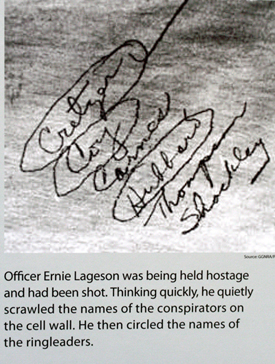 |
Officer Lageson wrote the names of the conspirators of the “Battle of Alcatraz” on the wall in case he or the other officers didn’t live to tell the story (Photo by Lily Stofman). |
“He got home safe,” said Lageson. “That’s all we cared about.”
After this incident, the Lagesons moved off the island. After all his father went through, he continued to work as a guard.
Even though Lageson experienced this agonizing event, no one will hear him utter anything bad about his experience living on the island.
“My best memory was my relationships with all the other kids,” said Lageson. “All the families were friends, we were such a close knit group.”
Although terrible things did happen, they were obviously rare occurrences.
Life on the island was mostly peaceful and serene and most inmates were not the monsters they were portrayed to be.
| The high watch-tower was the only place on the island where the officers were allowed to have guns and weapons (Photo by Lily Stofman). |
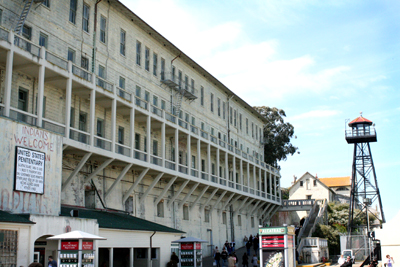 |
“It was an island tradition that all the children went Christmas caroling each year,” said Don Hurley, son of an Alcatraz officer and an island resident from 1942 to 1953, who also wrote about his experience as part of an exhibit called Family Life on The Rock.
“On the way we passed near the southwest part of the prison … we stopped and sang a couple of carols. Then all the children would yell, ‘Merry Christmas’ to the inmates. Within a few seconds, many shouts of a similar nature would echo back. The same event would happen every year, and each year I thought that our happiest night must have been one of their saddest,” he wrote.
Like any small town or large city, Alcatraz had its share of violent crimes. However, life goes on in these places; the sun comes up every morning, the wind continues to blow and birds still chirp. Life as they knew it, for those lucky enough to call Alcatraz home, was just another day in paradise.
If You Go
- Alcatraz is open everyday except Christmas Day and New Year’s Day. The hours of operation vary with the season — departures are available every half-hour throughout the day beginning at 9 a.m. from Pier 33.
- There is no entrance fee, however there is a charge for the ferry service. This price includes the cell house audio-tour, available in seven different languages, which is highly recommended, as many feel like it is the best part of the tour. However, if you wish not to take the audio-tour, refunds are available by contacting the supervisor in the cell house bookstore.
- Alcatraz frequently sells out as much as a week or so in advance, especially during the summer months and holidays. It is recommended that you purchase tickets before arriving. Tickets may be purchased up to 60 days in advance.
- For schedules, prices, and to purchase tickets visit http://www.alcatrazcruises.com.
- Once on the island you can stay as long or as short as you wish. Two to three hours is the recommended amount of time needed to see the whole island.
- There is no food or drink allowed or sold on the island. Make sure to eat before visiting.

Comments are Closed